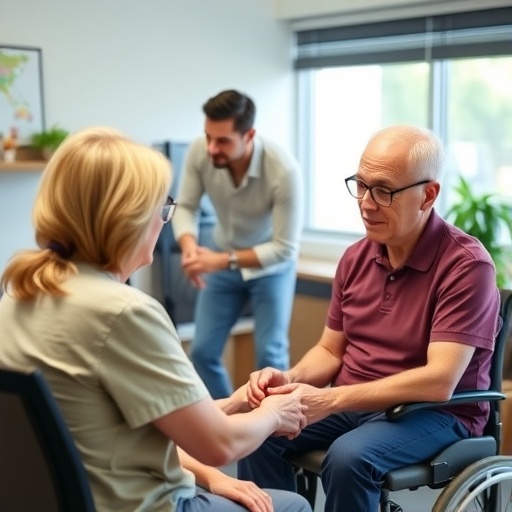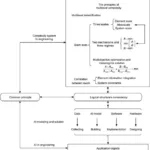
In recent years, Parkinson’s disease (PD) has increasingly been recognized not only for its hallmark motor symptoms but also for its complex constellation of non-motor manifestations. These non-motor symptoms—ranging from cognitive impairment and mood disorders to autonomic dysfunction and sleep disturbances—dramatically affect the quality of life of individuals living with PD. A groundbreaking study published in npj Parkinson’s Disease titled “Impact of an intensive outpatient rehabilitation on non-motor patients’ reported outcomes in PD: the INTENSO study,” spearheaded by Capecci, Baldini, Andrenelli, and colleagues, offers promising new insights into therapeutic interventions that specifically target these debilitating non-motor symptoms through intensive outpatient rehabilitation. This landmark research signals a paradigm shift in how rehabilitation protocols are designed for Parkinson’s patients, moving beyond traditional motor-centric approaches.
The INTENSO study represents one of the most comprehensive efforts to systematically assess the effects of an intensive outpatient rehabilitation program on patient-reported outcomes related to non-motor symptoms in PD. While motor symptom management through pharmacological means—primarily dopaminergic therapies—has been the mainstay of PD treatment, non-motor symptoms often remain under-recognized and under-treated. What sets the INTENSO study apart is its focus on outpatient rehabilitation regimens that blend physical therapy, cognitive training, psychological support, speech therapy, and autonomic nervous system regulation. This multimodal approach acknowledges the multifaceted nature of PD and aims to enhance overall functional capacity and life quality.
Delving into the mechanisms behind non-motor symptoms in PD reveals a complex neuropathological landscape involving widespread neurodegeneration beyond the nigrostriatal dopaminergic system. Neuroinflammation, cortical and subcortical atrophy, and neurotransmitter imbalances—including serotonergic, cholinergic, and noradrenergic pathways—contribute to the varied non-motor symptomatology. The INTENSO study hypothesized that intensive rehabilitation could induce neuroplastic changes across these affected neural networks, potentially mitigating symptom severity. To substantiate this, the research team utilized a battery of validated patient-reported outcome measures (PROMs), capturing emotional well-being, cognitive function, fatigue levels, sleep quality, and autonomic symptoms before and after the intervention.
.adsslot_Lifp5Zgvxb{ width:728px !important; height:90px !important; }
@media (max-width:1199px) { .adsslot_Lifp5Zgvxb{ width:468px !important; height:60px !important; } }
@media (max-width:767px) { .adsslot_Lifp5Zgvxb{ width:320px !important; height:50px !important; } }
ADVERTISEMENT
The study cohort comprised a diverse group of Parkinson’s patients experiencing significant non-motor symptoms, representing various disease stages and demographic profiles. Over several weeks, participants engaged in structured outpatient sessions totaling multiple hours per week, emphasizing consistency and intensity—key factors hypothesized to potentiate neuroplastic adaptation. Distinct from inpatient or self-guided therapies, this model provided professional supervision and real-time adjustments, tailoring the rehabilitation to individual patient needs and responses. This personalized aspect underscores the potential for outpatient settings to deliver highly effective, scalable interventions that can be integrated into routine clinical practice.
From a technical standpoint, the therapeutic modules incorporated in the INTENSO program leveraged cutting-edge techniques in neurorehabilitation. Cognitive training involved computer-assisted exercises targeting executive function, memory consolidation, and attentional control, essential areas often impaired in PD. Simultaneously, physical therapy emphasized balance, gait retraining, and coordination, mitigating fall risk while fostering motor control. Speech therapy interventions addressed hypophonia and dysarthria, prevalent motor speech disorders in PD, using adapted LSVT (Lee Silverman Voice Treatment) protocols. Psychological support sessions employed cognitive-behavioral strategies to reduce anxiety and depression, symptoms frequently exacerbated by chronic disease burden.
Results of the INTENSO study illuminate a statistically significant improvement in non-motor symptoms as gauged by composite PROM scores. Patients reported reduced fatigue, enhanced mood, and better sleep quality post-intervention, sustaining these gains even at follow-up evaluations weeks after program completion. Interestingly, improvements in autonomic symptoms—such as orthostatic intolerance and gastrointestinal dysfunction—were also documented, suggesting that intensive rehabilitation may influence visceral regulatory mechanisms through neuroplastic pathways. These findings position intensive outpatient rehabilitation as a potentially transformative adjunct to pharmacotherapy for comprehensive PD management.
One of the most compelling revelations from the INTENSO study is the strong correlation between patient engagement and outcome magnitude. Those adhering rigorously to the prescribed sessions exhibited more pronounced improvements, underscoring the importance of motivation and support structures. This insight has profound implications for clinical implementation, highlighting the need for healthcare systems to provide accessible, supportive environments conducive to sustained participation. Moreover, the study challenges traditional notions that intensive rehabilitation must occur in inpatient settings, demonstrating outpatient models as both feasible and effective.
The longitudinal approach adopted enabled the researchers to monitor not only immediate therapeutic effects but also the durability of benefits over time. Given PD’s progressive nature, sustained amelioration of non-motor symptoms translates directly into prolonged maintenance of independence and functional autonomy. The INTENSO study’s data suggest that repeated cycles of outpatient rehabilitation might yield cumulative gains or slow symptom progression, warranting future investigation into optimal dosing frequency and duration. This strategy could reshape chronic disease management paradigms, emphasizing proactive, continuous rehabilitation rather than episodic or reactive care.
Importantly, the multidisciplinary framework deployed in the INTENSO program fostered collaboration among neurologists, physiotherapists, neuropsychologists, speech therapists, and nursing staff. Such integrative models are essential in addressing the complex interplay of PD symptoms and tailoring interventions holistically. The study’s success further validates the concept that neurological rehabilitation benefits from coordinated care pathways, potentially reducing healthcare costs by preventing complications and hospitalizations related to non-motor symptom burdens.
The technological underpinnings supporting the INTENSO rehabilitation protocol also deserve attention. Advances in wearable sensor technology, telemedicine platforms, and virtual reality-enhanced cognitive training offer exciting prospects for scaling and customizing outpatient rehabilitation. Although the INTENSO study itself focused on in-person sessions, it sets the stage for integrating digital health tools to augment access, adherence, and feedback precision. This future direction aligns with broader trends in neurology toward harnessing technology for personalized, data-driven care in chronic neurodegenerative diseases.
Critically, the study acknowledges limitations, including the need for larger, randomized controlled trials to confirm generalizability across diverse populations and healthcare systems. Additionally, elucidating the precise neurobiological mechanisms through neuroimaging and biomarker studies remains an open frontier. Understanding how intensive rehabilitation influences neuronal connectivity, neurotransmitter dynamics, and neuroinflammation will refine treatment targets and identify responders versus non-responders. Collaboration across research centers and disciplines will be pivotal to accelerate these advances.
In summary, the INTENSO study represents a significant leap forward in recognizing and addressing the non-motor symptom burden in Parkinson’s disease through an innovative outpatient intensive rehabilitation approach. By shifting the therapeutic lens toward comprehensive, neuroplasticity-driven rehabilitation interventions, it opens new avenues for improving patient quality of life. Its findings resonate beyond PD, suggesting scalable models applicable to other neurodegenerative conditions characterized by complex motor and non-motor impairments. As the medical community embraces these insights, patients stand to benefit from more nuanced, effective, and personalized treatment paradigms.
The implications of the INTENSO study underscore the urgent need to reframe clinical practice guidelines to incorporate intensive outpatient rehabilitation as a core component of PD management. Multi-stakeholder engagement—including healthcare providers, policymakers, patients, and caregivers—will be essential to realize this vision in routine care. Training programs for rehabilitation specialists must evolve to encompass the multidimensional needs of neurodegenerative diseases. Furthermore, raising awareness among patients about the value of such programs can enhance uptake and adherence, maximizing therapeutic impact.
As new therapies targeting molecular and genetic facets of Parkinson’s disease continue to emerge, rehabilitation strategies like those validated in the INTENSO study will be indispensable complements to pharmacological interventions. The era of precision neurology demands integrative approaches addressing pathophysiology at multiple levels, from cellular biochemistry to behavioral function. Intensive outpatient rehabilitation exemplifies this principle, harnessing the brain’s adaptive capacities in conjunction with biological treatments to holistically confront Parkinsonian challenges.
Future research building on the INTENSO framework might explore synergistic effects of combining rehabilitation with novel neuromodulation technologies, such as transcranial magnetic stimulation or deep brain stimulation fine-tuning. Investigating the timing of rehabilitation initiation—whether early in the disease course or during advanced stages—could further optimize outcomes. Additionally, extending the model to address caregiver education and support may amplify benefits and improve the broader psychosocial ecosystem surrounding patients.
In conclusion, the transformative potential of the INTENSO study lies in its demonstration that intensive outpatient rehabilitation can meaningfully improve non-motor symptoms and overall quality of life for individuals with Parkinson’s disease. Through rigorous methodology, multidisciplinary collaboration, and patient-centered design, this research charts a new horizon for neurorehabilitation. As these findings diffuse through clinical practice and inspire further innovation, they offer renewed hope for patients confronting the multifaceted challenges of Parkinson’s disease.
Subject of Research: Intensive outpatient rehabilitation impacts on non-motor symptoms in Parkinson’s disease.
Article Title: Impact of an intensive outpatient rehabilitation on non-motor patients’ reported outcomes in PD: the INTENSO study.
Article References:
Capecci, M., Baldini, N., Andrenelli, E. et al. Impact of an intensive outpatient rehabilitation on non-motor patients’ reported outcomes in PD: the INTENSO study.
npj Parkinsons Dis. 11, 178 (2025). https://doi.org/10.1038/s41531-025-01035-7
Image Credits: AI Generated
Tags: autonomic dysfunction treatmentcognitive impairment in Parkinson’scomprehensive rehabilitation for PDinnovative therapies for Parkinson’s diseaseintensive outpatient rehabilitation for PDINTENSO study findingsmood disorders and Parkinson’s diseasenon-motor symptom management strategiesParkinson’s disease non-motor symptomspatient-reported outcomes in PDrehabilitation protocols for Parkinson’ssleep disturbances in Parkinson’s


